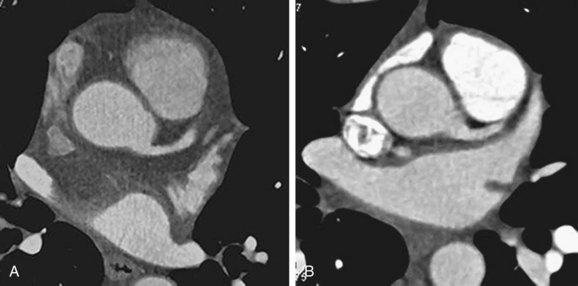CHAPTER 10 Radiation Dose Reduction Strategies in Cardiac Computed Tomography
A strategy for reducing radiation dose to the patient undergoing cardiac imaging should be employed particularly for patients at greatest risk for harm from x-ray exposure to the chest, young patients, and female patients.1 This plan should include educating patients on the risks of exposure to ionizing radiation, seeking alternative studies that do not rely on ionizing radiation (e.g., MRI or ultrasonography) when appropriate, assessing the risk/benefit ratio of CT for the individual patient, and applying the as low as reasonably achievable (ALARA) principle to the selection of CT scan parameters.
TECHNIQUE TO REDUCE X-RAY TUBE CURRENT
Technique Description
ECG-Based Reduction in Tube Current
During cardiac imaging, the x-ray tube current can be switched off or greatly reduced during systolic phases of the cardiac cycle significantly decreasing radiation dose. In patients with low, stable heart rates, data acquisition can be confined to a limited portion of the RR interval using prospectively ECG-triggered axial techniques. Average effective radiation doses of 2 to 3 mSv have been reported using these techniques to image the coronary arteries.2,3
Axial imaging is associated with increased sensitivity to arrhythmia, owing to prospective referencing of the ECG signal, and increased examination times, owing to incrementing the patient table between acquisitions. It is often necessary to acquire data during the entire cardiac cycle using a helical mode and retrospectively reference image reconstruction to a simultaneously recorded ECG signal. Although ECG-gated helical techniques require continuous x-ray exposure, tube current outside the phase of interest can be reduced to decrease patient radiation dose significantly. Effective radiation doses can easily exceed 15 mSv4 using helical imaging without ECG-based dose modulation, but can be reduced 50% or more depending on patient heart rate,5 the minimum tube current value,6 and the duration of the full tube current window.7
Size-Based Reduction in Tube Current
The x-ray tube current can be reduced for slimmer patients. Attenuation of the incident x-ray beam decreases with the thickness of the tissue between the x-ray source and the detector such that less radiation exposure is required to penetrate thinner tissues and achieve desired image noise (Fig. 10-1). Patients can be assigned to size categories based on visual inspection, weight, body mass index, or cross-sectional body measurements from scout images,8 and the tube current can be adjusted manually to a predefined value. Weight-adapted tube current protocols were shown to reduce coronary CT angiography dose by 18% in men and 26% in women9 at one institution.
Automatic methods of online adaptation of tube current to patient size can also be used to reduce dose. The tube current can be modulated along the x, y, and z directions during scanning based on local tissue thickness without sacrificing image noise. Tube current is reduced at projection angles and table positions requiring less x-ray penetration. Online, anatomic-based tube current modulation has been shown to reduce radiation exposure to the thorax by 20% compared with a fixed tube current while maintaining image noise.10
Pitfalls and Solutions
ECG-Based Reduction in Tube Current
Helical data acquisition with retrospective ECG gating is less susceptible to cardiac motion artifacts and provides an alternative to axial imaging at high or irregular heart rates. ECG-based tube current modulation is prescribed before scanning, however, so changes in heart rate could result in unintended reduction of the tube current during a desired phase of reconstruction for a given cardiac cycle. Some CT systems allow adjustment of the full tube current duration, increasing the utility of ECG-based tube current modulation for patients with high or irregular heart rates because the optimal reconstruction phase is less predictable.7
Stay updated, free articles. Join our Telegram channel

Full access? Get Clinical Tree


 such that a 20% reduction in tube current results in a 12% increase in image noise.
such that a 20% reduction in tube current results in a 12% increase in image noise.
 FIGURE 10-1
FIGURE 10-1